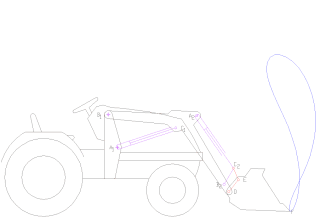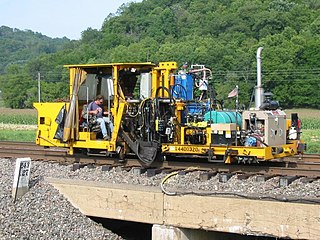
A forklift is a powered industrial truck used to lift and move materials over short distances. The forklift was developed in the early 20th century by various companies, including Clark, which made transmissions, and Yale & Towne Manufacturing, which made hoists. Since World War II, the use and development of the forklift truck have greatly expanded worldwide. Forklifts have become an indispensable piece of equipment in manufacturing and warehousing. In 2013, the top 20 manufacturers worldwide posted sales of $30.4 billion, with 944,405 machines sold.

An elevated passenger ropeway, or chairlift, is a type of aerial lift, which consists of a continuously circulating steel wire rope loop strung between two end terminals and usually over intermediate towers, carrying a series of chairs. They are the primary onhill transport at most ski areas, but are also found at amusement parks and various tourist attractions.

A crane is a type of machine, generally equipped with a hoist rope, wire ropes or chains, and sheaves, that can be used both to lift and lower materials and to move them horizontally. It is mainly used for lifting heavy objects and transporting them to other places. The device uses one or more simple machines to create mechanical advantage and thus move loads beyond the normal capability of a human. Cranes are commonly employed in transportation for the loading and unloading of freight, in construction for the movement of materials, and in manufacturing for the assembling of heavy equipment.

A loader is a heavy equipment machine used in construction to move or load materials such as soil, rock, sand, demolition debris, etc. into or onto another type of machinery.

A radial arm saw is a cutting machine consisting of a circular saw mounted on a sliding horizontal arm. Invented by Raymond DeWalt in 1922, the radial arm saw was the primary tool used for cutting long pieces of stock to length until the introduction of the power miter saw in the 1970s.

A baler or hay baler is a piece of farm machinery used to compress a cut and raked crop into compact bales that are easy to handle, transport, and store. Often, bales are configured to dry and preserve some intrinsic value of the plants bundled. Different types of balers are commonly used, each producing a different type of bale – rectangular or cylindrical, of various sizes, bound with twine, strapping, netting, or wire.

A skidder is any type of heavy vehicle used in a logging operation for pulling cut trees out of a forest in a process called "skidding", in which the logs are transported from the cutting site to a landing. There they are loaded onto trucks, and sent to the mill. One exception is that in the early days of logging, when distances from the timberline to the mill were shorter, the landing stage was omitted altogether, and the "skidder" would have been used as the main road vehicle, in place of the trucks, railroad, or flume. Modern forms of skidders can pull trees with a cable and winch, just like the old steam donkeys, or with a hydraulic grapple either on boom or on the back of the frame (clambunk skidder).

Maintenance of way refers to the maintenance, construction, and improvement of rail infrastructure, including tracks, ballast, grade, and lineside infrastructure such as signals and signs.

A spike driver is a piece of rail transport maintenance of way equipment. Its purpose is to drive rail spikes into the ties on a rail track to hold the rail in place. Many different sizes of spikers are manufactured and in use around the world.

A tamping machine or ballast tamper, informally simply a tamper, is a self-propelled, rail-mounted machine used to pack the track ballast under railway tracks to make the tracks and roadbed more durable and level. Prior to the introduction of mechanical tampers, this task was done by manual labour with the help of beaters. As well as being faster, more accurate, more efficient and less labour-intensive, tamping machines are essential for the use of concrete sleepers since they are too heavy to be lifted by hand.

The Meillerwagen was a German World War II trailer used to transport a V-2 rocket from the 'transloading point' of the Technical Troop Area to the launching point, to erect the missile on the Brennstand, and to act as the service gantry for fuelling and launch preparation.

A work train is one or more rail cars intended for internal non-revenue use by the railroad's operator. Work trains serve functions such as track maintenance, maintenance of way, revenue collection, system cleanup and waste removal, heavy duty hauling, and crew member transport.

A stairclimber is a type of trolley fitted with rotating wheels or tracks so that it can be pushed or pulled up or down steps or a stairway. Stairclimbers can be manual or battery-powered, and are commonly found in wheel, track, push arm or walker variants.

A ballast regulator is a piece of railway maintenance equipment used to shape and distribute the gravel track ballast that supports the ties in rail tracks. They are often used in conjunction with ballast tampers when maintaining track.

A tie crane or tie handler, is a piece of rail transport maintenance of way equipment used to move and handle the railroad ties used in rail tracks using track relaying. The machines are used as an alternative to the manual labor once used. Tie cranes frequently work with tie extractor/inserters to replace ties as part of a section gang.

A spreader is a type of maintenance equipment designed to spread or shape ballast profiles. The spreader spreads gravel along the railroad ties. The various ploughs, wings and blades of specific spreaders allow them to remove snow, build banks, clean and dig ditches, evenly distribute gravel, as well as trim embankments of brush along the side of the track. Spreaders quickly proved themselves as an extremely economical tool for maintaining trackside drainage ditches and spreading fill dumped beside the track.

Loram Maintenance of Way, Inc. is a railroad maintenance equipment and services provider. Loram provides track maintenance services to freight, passenger, and transit railroads worldwide, as well as sells and leases equipment which performs these functions.

A track renewal train is a work train that consists of many units of machinery and materials required for track renewal projects.

A catenary maintenance vehicle is a railroad maintenance of way vehicle that is used to maintain and inspect overhead line on electrified railroad or metro tracks. Such vehicles are typically self-propelled by a diesel engine, to allow them to operate when power is shut off to the overhead lines for worker safety or in the event of a power failure. Catenary maintenance vehicles allow maintenance of way workers to safely work on overhead wires and typically include a crane to install or remove wires as needed.

A spike puller is a railroad maintenance of way machine designed to remove rail spikes from ties. The spike puller automates the task of spike removal, allowing it to be done at a rate greater than can be achieved by hand. Spike pullers range from small hand operated hydraulic machines to self propelled machines controlled by an operator in an enclosed cab.





















